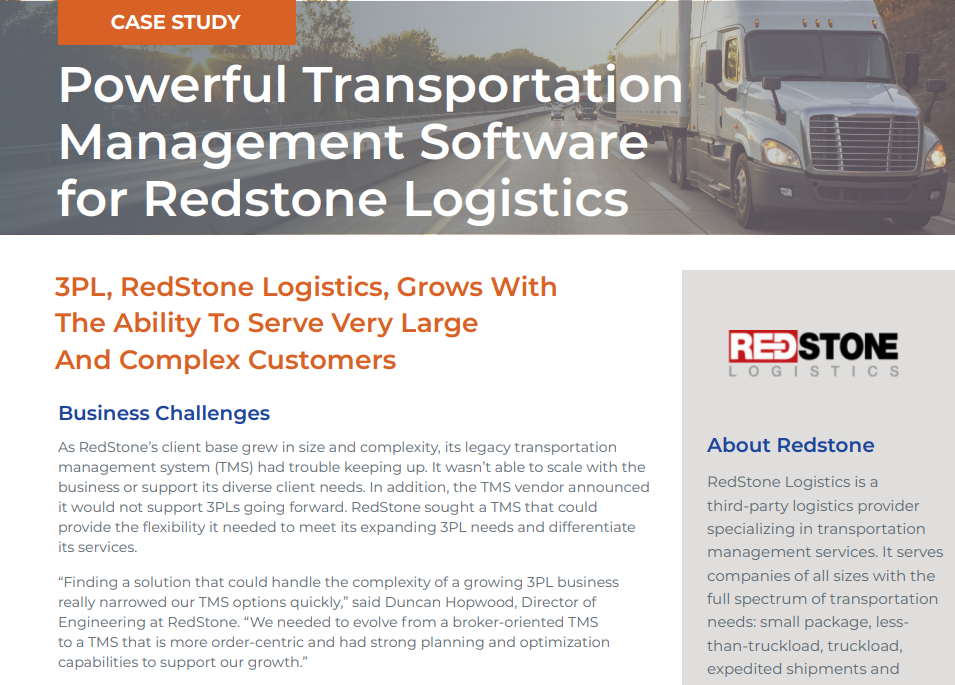RedStone Logistics, a third-party logistics (3PL) company, provides a full spectrum of transportation needs: parcel, LTL, truckload, expedited and air shipments, as well as consulting services.
With industry-leading technology and continuous improvement for year-over-year performance, RedStone helps clients save money and improve internal processes.
Challenge
As RedStone’s client base grew in size and complexity, its legacy transportation management system (TMS) had trouble keeping up. It wasn’t able to scale with the business or support its diverse client needs; in addition, the TMS vendor announced it would not support 3PLs going forward. RedStone sought new 3PL transportation management software that could provide the flexibility it needed to meet its expanding 3PL needs and differentiate its services.
“Finding a solution that could handle the complexity of a growing 3PL business really narrowed our TMS options quickly,” said Duncan Hopwood, Redstone’s Director of Engineering. “We needed to evolve from a broker-oriented TMS to a TMS that is more order-centric and had strong planning and optimization capabilities to support our growth.”
Solution
A successful 3PL TMS project comes down to how it serves the 3PL, its customers and in a structure that works for the TMS vendor. It’s a “win-win-win” relationship that must help the 3PL win by closing new business and retaining customers at an appropriate cost and with good margins; it must create value for the end-customer with a combination of reduced freight costs and enabled logistics initiatives; and finally, the TMS provider must make a fair profit.
For RedStone, the choice for TMS software came down to 3G and another Tier 1 TMS vendor.
Vendor Review
When comparing cost between the two systems, RedStone examined how each transportation management system vendor controlled the annual cost of the software (total cost of ownership – TCO) – in terms of annual recurring SaaS fees and other ongoing costs – that would affect how RedStone would maintain its margins.
“It turned out that the true TCO for 3G was far lower than its competitor, even though the quoted SaaS price was a little higher. I’d heard that the other vendor quoted low SaaS prices but then added significant costs for maintenance and onboarding new accounts,” explained Hopwood. “Plus, 3G’ customer-focused culture is evident and not something I’ve seen with many other software companies.”
With the 3G solution, RedStone has the freedom to self-configure the TMS without relying on a vendor for the changes. In addition, 3G could handle the complexity RedStone needed to serve its diverse clients and integrate them quickly.
Results
3G enabled RedStone to attract larger clients thanks to its ability to handle their complex and varied logistics requirements. For example, 3G had the flexibility and power to support RedStone’s creative pricing strategies – a fundamental piece of the company’s business model that drives its growth. They have since attracted industry leaders in e-commerce, automotive and freight hauling. “We couldn’t have met these clients’ needs with our old TMS,” said Hopwood. “In all cases, the common thread was that 3G allowed us to handle reasonably complex information for planning purposes and save our clients a lot of money.”
Sophisticated TMS to Support Large Clients
When one client had a unique savings opportunity that involved multi-stop truckload combined with pool distribution throughout the southeastern U.S., RedStone was able to manage that challenge successfully. “It was a beautifully complex,” noted Hopwood.
“The 3G optimization considers more possibilities than any other TMS on the market, which helped us drive down costs for this client and markedly improve their service.”
Rapid Customer Onboarding in Weeks
RedStone’s growth is based on blending the power of unique services and pricing models along with excellent customer service. Key to this is the easier and more efficient on-boarding of its customers:
“On average, we’ve gone from a 10-12 week on-boarding range to just a few weeks,” explained Hopwood. “With 3G, we’ve dramatically sped up implementations due to smoother and quicker systems implementations, and the support for differentiated services has allowed us to deliver value to our clients faster.”
Value-Proving Optimization Modeling
Hopwood continued, “Many TMS products struggle using optimization in routing and executing freight. We’d heard about the problems of some products showing optimization results that look great, but stumbling when the organization tries to run the loads that were built.
3G produced results that allowed us to win some big accounts. More importantly, the product produces results that can be executed and provides unique tools to execute the results. This allows us to create value for our customers and keep them happy.”
Ensuring Better 3PL Process Flows and Productivity
The RedStone team has also found value in the 3G Health Check, an evaluation and verification review. No different than the maintenance attention one would give a home or vehicle, the Health Check examines a customer’s use of the 3G solution every 12-18 months to ensure the investment is maximized and the system is performing at optimal levels.
“The Health Check pushed us to set better process flows internally and improve productivity,” said Hopwood.
The 3G culture, which factored into RedStone’s initial purchase decision so heavily, has proven to be another key advantage through implementation and beyond. “A good vendor partner is expected for getting through the easy, day-to-day stuff,” said Hopwood. “But the real measure of 3G is how everyone steps up when things get tough. They have been a great partner.”





